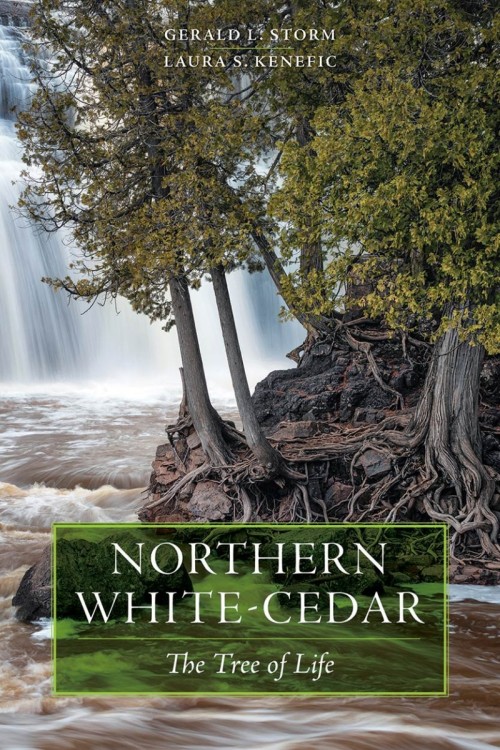by Gerald L. Storm and Laura S. Kenefic
Michigan State University Press, 2022
I grew up on a large tree farm in western Connecticut, and my family’s backyard tree nursery was surrounded by northern white-cedars. White-tailed deer browsed the trees’ lower branches, birds nested in the dense upper boughs, and red squirrels would strip off outer bark. We kids would line the floor of our debris forts with the fragrant, flat lying branches, and along with our dad, feast on nearby raspberries.
From childhood experiences, and as a forester practicing in the Northeast, I thought I knew more than enough about northern white-cedar. Then I read Gerald Storm and Laura Kenefic’s excellent book – a holistic story of this valuable, but poorly understood conifer species. This is the product of a six-year-long collaboration between Kenefic, a research forester for the USDA Forest Service’s Northern Research Station and faculty associate at University of Maine, and Storm, a retired U.S. Department of the Interior wildlife biologist from northern Wisconsin. Published posthumously for Storm, the book also includes input from a host of other scientists and historians.
Ironically, although modern taxonomy distinguishes northern white-cedar as a juniper instead of a “true” cedar, its common name derives from an ancient Greek word for juniper wood, revered for its durability and referred to as kedros. Latinized into cedrus, the word made its way into the English language as a term for any durable wood derived from fragrant conifers. The species’ other common name, the Latin/French fusion “L’arbre de vie,” or “arborvitae” (tree of life), dates from an encounter between 16th century French explorer Jacques Cartier and a Haudenosaunee tribe in eastern Canada. This Quebec tribe provided Cartier and his ice-stranded crew a white-cedar decoction, rich in vitamin C, that saved them from the ravages of winter scurvy. Cartier was the first to bring the tree’s seeds home to France, where they grew in the royal gardens at Fontainebleau and subsequently were shared throughout Europe.
The authors portray this tree as an “introvert” amongst its neighbors in a forest community. It thrives in the wettest of wooded swamps where other trees cannot. It can slowly grow in the shade of more vigorous species and also tolerates the very dry, rocky headlands along seacoasts, cliffs, and lake shorelines throughout northeastern forests.
Another incongruous feature of northern white-cedar is its woody heart, which is prone to decay while the tree is alive, but once the tree dies, is remarkably rot-resistant, and a preferred wood for shakes and fenceposts. The authors note how birds and flying squirrels exploit the wood’s natural insect-repellent quality, and travel long distances to strip outer bark with which to line their nests.
The book also addresses threats to northern white-cedar forests, including fragmentation, harvest pressures, and especially white-tailed deer over-browsing of seedlings, which sadly, in many areas, is destroying the northern white-cedar forests of the future. More aggressive deer herd management and/or reintroduction of extirpated natural predators are the obvious solutions to this threat, as the authors make clear in their description of related research.
The wildlife chapter subtitled “Friends and Neighbors” describes myriad other organisms that benefit from and rely on northern white-cedars. The authors begin by describing symbiotic fungi and miniscule leaf miner insects that both benefit and detract from the trees’ success, and then progress through the entire host of fauna and flora that constitute a northern white-cedar forest’s food web. To visually support these ecological lessons, they engaged the colorful artistry of Wisconsin artist Michael A. Klafke, who illustrates the tree’s importance to snowshoe hares, pileated woodpeckers, black bear, and beaver to name but a few. Along with the excellent photographic plates and pen-and-ink sketches throughout the text, these scenes make Northern White-Cedar: Tree of Life even more enjoyable and worthy of adding to one’s bookshelf.


